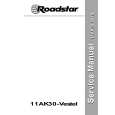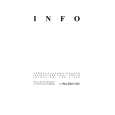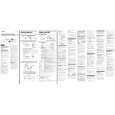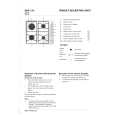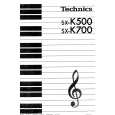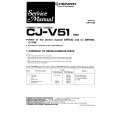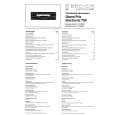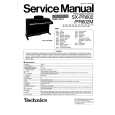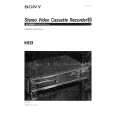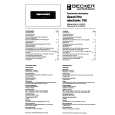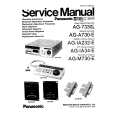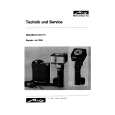|
|
|
Productos
|
|
Información
|
|
Destacado
|
|
|
 |
|
|
No hay comentarios de productos.
EN 52
9.
SD-4.00SA_CH
Circuit Descriptions, List of Abbreviations and IC Data
� One for CD with a wavelength of 780 nm. � One for DVD with a wavelength of 650 nm. The TZA1033 (item 7105) controls the data from these lasers, and the supply to them. 9.2.2 Front-end: the Servo Part
The spindle-motor interface provides both motor control signals from the demodulator and, in addition, contains a tachometer loop that accepts tachometer pulses from the motor unit. They drive the motor IC (BA6665FM, item 7300). The SAA7812 has two independent microcontroller interfaces. The first is a serial I2C-bus and the second is a standard 8-bit
The front-end consists of: � The Loader interface � The Servo Processor/Decoder � The Interface/Program Memory The Loader Interface The TZA1033HL/K2 (or DVDALAS2plus, item 7105) is an analogue pre-processor and laser supply circuit. It contains data amplifiers and several options for radial tracking and focus control. It is possible to optimise the dynamic range of this pre-amp/ processor combination for the LF servo and RF data paths. The gain in both channels is separately programmable. This will guarantee an optimal playability for all kind of discs. Also, a dual laser supply is implemented, with fully automatic laser control including stabilisation and an ON/OFF switch, plus a separate supply pin for power efficiency. The Servo Processor/Decoder In the SD3.0 module, the servo signals were fed to the MACE2 servo processor, while the HF output signal was fed to the SAA7335 decoder. In the new SD4.0SA_CH module, these ICs are combined into one chip: the SAA7812 Iguana. This chip contains the following blocks: channel decoder, block decoder, servo processor, and microcontroller. The servo circuit in the SAA7812 (item 7207) takes care of the servo controls. In a CD system, there are some twelve control loops active. About six of them are needed to adjust the servo error signals that is once per disc rotation. It also adjusts offsets, signal amplitudes, and loop gains (AGCs), to enlarge system robustness and to avoid expensive potentiometer adjustments in production. The other six loops determine the laser spot position on the disc in the radial, axial (focus), and tangential directions. It also has to take care that the spot accesses a required position as fast as possible. This access system consists of two parts, namely the actuator and the sled, which are (within a certain range) mechanically and electrically independent. Therefore, during an access, the servo has to control as well the actuator as the sled. The analogue signals, from the diode pre-processor, are converted into a digital representation using A/D converters. For the communication between the host processor (STi55xx) and the servo processor, the S2B bus is used. This bus supports full-duplex asynchronous communication. The SAA7812 is also a combined CD/DVD compatible decoding device. The device operates with built in hardware for CD/DVD error correction and de-interleaving operations. It decodes EFM or EFM+HF signals directly from the laser preamplifier, including analogue front-end, PLL data recovery, demodulation, and error correction. Its analogue front-end input (the channel decoder), converts the HF input signal to the digital domain via an 8-bit ADC, preceded by an AGC circuit to obtain the optimum performance from the converter. An external resonator clocks this block. This subsystem recovers the data from the channel stream. It corrects asymmetry, performs noise filtering and equalisation, and finally recovers the bit clock and data from the channel using a digital PLL. The demodulator part detects the frame synchronisation signals and decodes the EFM (14 bit) and EFM+ (16 bit) data and sub-code words into 8-bit symbols. Via the serial output interface, the I2S data (audio and video) go to the DVD decoder STi55xx.
multiplexed parallel interface. Both of these interfaces provide access to 32 8-bit registers for control and status. The Interface/Program Memory The interface between front-end (SAA7812) and back-end (Sti55xx) is via: � I2S bus (BCLK, DATA, WCLK, FLAG, SYNC and V4). � S2B bus (RXD_S2B, TXD_S2B, CPR_S2B and SUR_S2B). � Miscellaneous I/O ports (RSTNF= front-end reset, EANF= front-end processor boot select). Service tip: These lines contain series resistors (47 or 100 �) for easy hardware debugging, and for EMC/noise reduction of the high-speed I2S lines. The front-end processor SAA7812 (Iguana) has two boot modes: normal boot from flash memory, or serial mode. The boot selection is via the EANF pin. The Iguana samples the EANF signal level once during boot-up. Once boot-up is completed, this pin is no longer used for this purpose. However, in the SD4.0SA_CH circuit, the EANF is also connected to the flash memory. Therefore, when this pin is LOW, the lower 1Mbits of the memory is accessible. Conversely, when this pin is HIGH, the upper 1Mbits is accessible. Under front-end normal operation, the program memory (less than 1Mbits in size) should reside in the lower bank. Therefore, the EANF pin should be LOW at all times. Since the actual flash memory used is 2Mbits, the upper 1Mbits is unused. This area is reserved for possible use by the front-end self-diagnostic software, or flash download application. 9.2.3 Back-end: the Digital Part The back-end consists of: � DVD back-end processor � SACD DSD processor � Audio output � Video output � Clock factory � Miscellaneous DVD Back-end Processor The SD4.0SA_CH is designed for the Sti55xx family. Some of the DVD related features of these ICs are:
Processor overview
Function Basic CD/VCD/DVD decoding Extra 2-channel of I2S output (PCMDATA3) Karaoke DTS Audio post processing (equalizer, level meter, etc) DVD audio Progressive scan at analog video output STi5580 X X X X STi5588 X X X X X X X
CL 16532163_048.eps 240102
STi5519 X
Figure 9-2 Processor overview
The STi5580 has the same architecture as the STi5508 (used in earlier DVD generations), and is pin-to-pin compatible. It works on 3.3 V (VDD), and comprises the following functions: � Video decoder, which supports MPEG1 and MPEG2. � Audio decoder that supports AC-3, MPEG1, MPEG2, DTS, PCM, S/PDIF, and MP3. � PAL/NTSC video encoder with simultaneously Y/C, CVBS, and RGB/YUV outputs.
|
|
 |
> |
|
